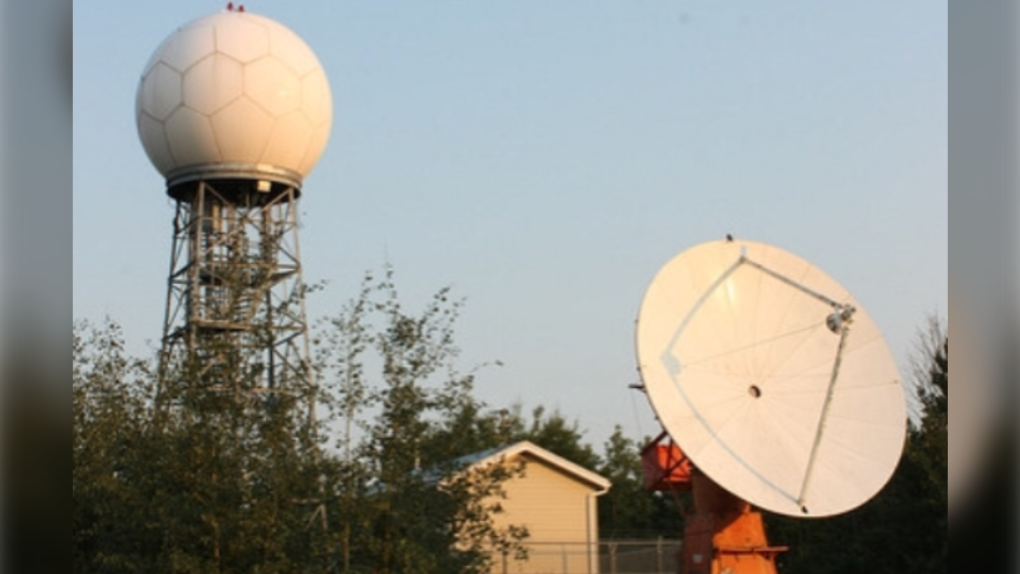Like watching weather radar? Here's why you won't see much for a few months
 A photograph of Carvel Weather Radar Station located near Beach Corner, Alta. (Source: Jeff Adam)
A photograph of Carvel Weather Radar Station located near Beach Corner, Alta. (Source: Jeff Adam)
Edmonton is getting its biggest weather tech update in decades. The radar at Carvel (35 km west of Edmonton) went Doppler in 1991 and is now going “Dual Pol”.
Once the work at the Carvel radar is done, radar coverage of Edmonton and surrounding areas will get significantly better. Dual-Polarization radars are a massive improvement over the technology currently being used. But, until then, it’ll be tougher to track precipitation coming into the Edmonton area (particularly from the west and northwest).
The area won’t be completely without radar coverage, though. Environment & Climate Change Canada has the ability to switch it back on in the event of severe weather (but only up until late September. After that, it’ll be offline for good.) ECCC has also extended the range of nearby radars from 240 km to 400 km.
However, because of the way radar works, rain (or snow in the coming months) that falls from low clouds likely won’t be detected or show up on radar maps. The tilt of the radar beam from far-off radar sites will simply be “too high” above the city.
Think of holding a flashlight tilted slightly upwards. The light may only be a few feet off the ground in your hand, but the beam is much higher above the ground 10, 20 or 30 feet away. That’s what we’ll be dealing with in regards to radar coverage.
That short-term “pain” will pave the way for a BIG long-term gain.
Dual-Polarization radars scan the atmosphere both horizontally and vertically. Among the many benefits of this, dual-polarization allows for better “precip-typing” (figuring out what’s snow and what’s rain). The upgrade will also improve our ability to determine the size of hail and will make it easier to eliminate non-precipitation echoes (birds, bugs, dust etc) from the radar images.
This is all part of a nationwide project to modernize Canada’s 31 radar sites and to add a new radar near Fort McMurray. The project began with the radar near Radisson, SK in 2017 and will wrap up in 2023. So far, 21 radars across the country have gone “Dual Pol”.
CTVNews.ca Top Stories

opinion Tom Mulcair: Prime Minister Justin Trudeau's train wreck of a final act
In his latest column for CTVNews.ca, former NDP leader and political analyst Tom Mulcair puts a spotlight on the 'spectacular failure' of Prime Minister Justin Trudeau's final act on the political stage.
B.C. mayor gets calls from across Canada about 'crazy' plan to recruit doctors
A British Columbia community's "out-of-the-box" plan to ease its family doctor shortage by hiring physicians as city employees is sparking interest from across Canada, says Colwood Mayor Doug Kobayashi.
'There’s no support': Domestic abuse survivor shares difficulties leaving her relationship
An Edmonton woman who tried to flee an abusive relationship ended up back where she started in part due to a lack of shelter space.
Baseball Hall of Famer Rickey Henderson dead at 65, reports say
Rickey Henderson, a Baseball Hall of Famer and Major League Baseball’s all-time stolen bases leader, is dead at 65, according to multiple reports.
Arizona third-grader saves choking friend
An Arizona third-grader is being recognized by his local fire department after saving a friend from choking.
Germans mourn the 5 killed and 200 injured in the apparent attack on a Christmas market
Germans on Saturday mourned the victims of an apparent attack in which authorities say a doctor drove into a busy outdoor Christmas market, killing five people, injuring 200 others and shaking the public’s sense of security at what would otherwise be a time of joy.
Blake Lively accuses 'It Ends With Us' director Justin Baldoni of harassment and smear campaign
Blake Lively has accused her 'It Ends With Us' director and co-star Justin Baldoni of sexual harassment on the set of the movie and a subsequent effort to “destroy' her reputation in a legal complaint.
Oysters distributed in B.C., Alberta, Ontario recalled for norovirus contamination
The Canadian Food Inspection Agency has issued a recall due to possible norovirus contamination of certain oysters distributed in British Columbia, Alberta and Ontario.
New rules clarify when travellers are compensated for flight disruptions
The federal government is proposing new rules surrounding airlines' obligations to travellers whose flights are disrupted, even when delays or cancellations are caused by an "exceptional circumstance" outside of carriers' control.


































